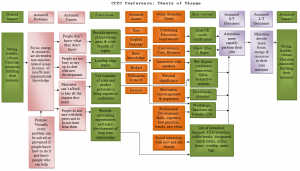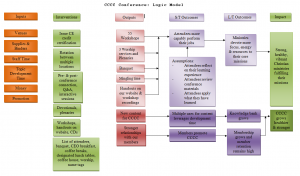Every program evaluation needs to be based on the rationale for why the program exists in the first place. Individual programs only exist because they support the ministry’s theory of change that describes how its vision will be accomplished through its programs. Only then can you develop a rationale for a program based on how it supports the ministry’s theory of change.
This post documents the theory of change and the logic model that are the rationale for the program we are reviewing, which is the CCCC Annual Conference. These models will make fundraising easier, particularly if your mission does not produce short-term observable results. If donors understand the theory and logic of what you are doing, they will more readily fund programs that make sense to them.
Theory of Change
The theory of change is all about ensuring that you are doing the right things. It is mostly about effectiveness.
It’s important that you know why you provide a certain program and understand all of the assumptions you have made about it. The theory of change is how you document why you believe this program will result in changes that will help you fulfill your mission. It also helps you find assumptions you may not even be aware that you have made. Here is the theory of change for the CCCC conference. If you click on the picture of the model it will open up large enough that you can read it.

How to Develop a Theory of Change
You can find detailed instructions for how to develop a theory of change and a template you can use in the post Theory of Change: A Step-By-Step Guide to Developing a Customized Plan For Your Ministry.
Logic Model
The logic model is all about ensuring that you are doing things right. It is mostly about efficiency.
Once you have a theory of change, you can do a logic model. The interventions column from the theory of change comes over to the logic model. The columns are essentially the same between the two models, although I reworded one of the boxes for the logic model.

Inputs
First you document all of the inputs that make the program work. The general categories of inputs are physical assets (buildings), time and money. I’ve been a bit more detailed on this logic model because as I created the model I realized that not only were there benefits for our members, but there were benefits in the program for CCCC too. Since the goal is to ultimately compare inputs against outputs, I thought it only fair to allocate the time that benefits CCCC separately from the time that benefits our members. This simply recognizes that the content created by staff for their workshops can be used in multiple ways beyond the conference itself.
Interventions
As already mentioned, this is the list of program activities and is the same as the list in the theory of change.
Outputs
Outputs represent the completion of the program. When the outputs are done, you can say “We did our part, now the beneficiaries have to do their part.” Outputs could be the number of presentations of the Gospel, or it might be the number of people given glasses. They could be the number of Bibles handed out or the number of Sunday School classes and attendees. Whatever the outputs are, they are what you used the inputs for and did the activities for.
The outputs tell you how busy you’ve been.
Outcomes and Impact
These are the same as in the theory of change model. The outcomes and impact will tell you how effective you’ve been.
Where to from Here?
Now that you have your theory of change and logic model, go over them very carefully and think hard about any assumptions you are making. You will want to check all the assumptions. Of course, at least some of your assumptions have turned up in the models themselves. For example, I made assumptions in coming up with the causes of the problem and with the attendees needs which I included in the models, but there are many, many more that I have listed and which form the basis for the research questions, which I’ll be blogging about later.
You now have two models that, put together, will help you check that you are doing the right things right. The next time I post on this program review, I’ll discuss reviewing the literature as a key part the review process.



Thank you 🙂